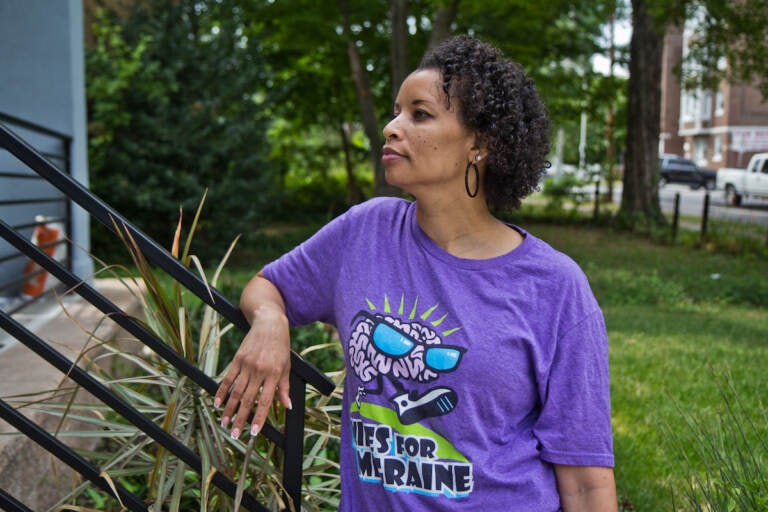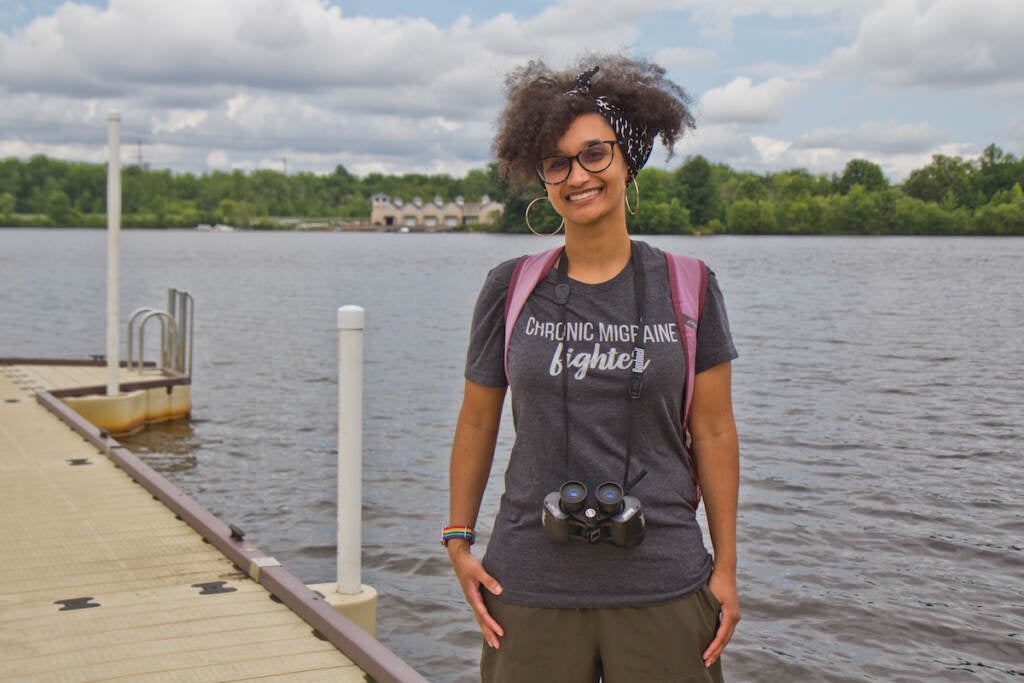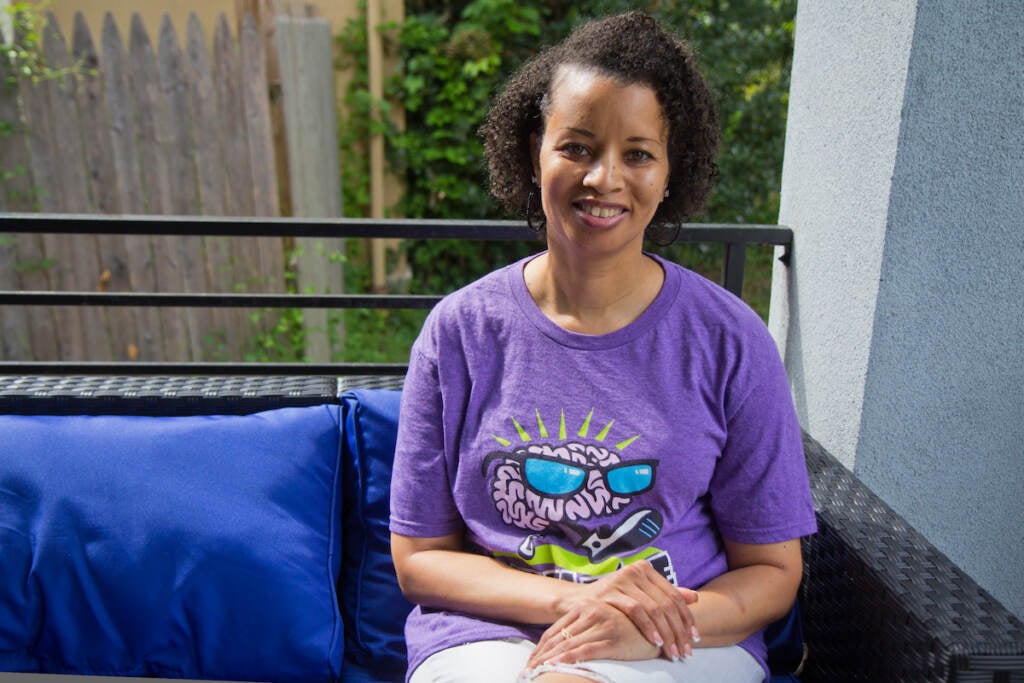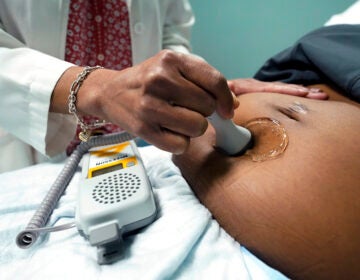People of color face discrimination in diagnosis and treatment of migraines, advocates say
Patient advocates are trying to address the disparities people of color face while trying to get a migraine diagnosis or treatment.
Listen 4:25
Deborah Turk is a chronic migraine sufferer who’s fighting to have a mental health diagnosis removed from her medical records she believes was given to her out of bias. (Kimberly Paynter/WHYY)
Sarah Shaw vividly remembers her first migraine attack. She was 24, and wandering through a haunted corn maze during the Halloween season.
Shaw recalls a sudden feeling of nausea and an intense pain in her head. The lights seemed brighter, the sounds louder — and the maze became a lot scarier than she expected.
“It sounded like everyone was yelling and screaming, but they weren’t. It sounded like they had a megaphone, and they were all yelling at it all at the same time,” Shaw, now 33, remembered.
The West Windsor, New Jersey, resident visited two doctors, but neither gave her a correct diagnosis — one recommended anxiety medication. Shaw said she didn’t feel empowered to advocate for herself at the time.
“I got really discouraged, because it was like, ‘If nobody can figure out what’s wrong with me, is it all in my head?’” Shaw said. “I definitely got discouraged, and it made me not want to go to the doctor.”

It wasn’t until one year later that Shaw, who is Black, was diagnosed with migraine disease, after a pharmacist recognized her symptoms and encouraged her to find a neurologist.
Along with an intense stabbing headache, migraine symptoms can include sensitivity to light or sound, vertigo, vision changes, speech problems, brain fog, and severe fatigue. Migraine attacks are unpredictable, and patients can miss school, hobbies, weddings, and even lose their jobs.
Shaw’s experience is not that unusual for people of color, according to patient advocates. Though rates of migraine disease are similar across races, several studies report the level of care people of color receive is less adequate compared with the attention given to white patients.
One study published in “Neurology” last year found that Black patients are less likely than white patients to receive a headache diagnosis (47% versus 70%), and less likely to receive a prescription for migraine medication (14% versus 37%).
Dr. Courtney White, a migraine specialist at Jefferson Health who is Black, also had difficulty getting appropriate treatment for her own migraine disease. She said migraine health disparities partly stem from a history of racism within the medical field, which upheld false beliefs that Black and white bodies were different, including that Black people had thicker skin and couldn’t feel pain. Some doctors continue to perpetuate those beliefs today, White said, adding that a provider once insisted that she didn’t feel pain.
“So when a [Black] patient comes into the ER with migraine symptoms … they’re more likely to be dismissed,” she said.
When a patient is misdiagnosed or their treatment is delayed, their migraine symptoms can worsen, White said.
“By the time a lot of patients get to me, they’ve already developed chronic migraine, and it’s much more difficult to treat,” she said.
Health care advocates seek to support people of color
Migraine disease has also been wrongly framed as a middle-aged white woman’s disease, White said, and for a long time, pamphlets and TV ads were centered around this group of people.
“I’ve had several patients who came to me, and when I’ve diagnosed them with migraine, they’ve said, ‘I didn’t think that was something I could have,’” she said. “We’re trying to show a more diverse range of people who do have this disease and what it can look like, but it’s still got a long way to go.”
That’s why in 2021 Qasim Amin Nathari started the social media presence Black Men Have Migraine Too.
“Sadly, I’m clearly the most visible and most vocal, and it shouldn’t be that way,” said the 58-year-old migraine patient.

Nathari was diagnosed with migraine disease in his early 30s after more than two decades of symptoms. Nathari moved to Jacksonville, Florida, from Newark, New Jersey, in 2016, partly because his migraines are triggered by colder climates.
Nathari said his migraine attacks are so severe that he cannot work full time.
He said his migraine disease also has impacts on activities as simple as driving. As Black man, he said he worries he could be profiled by police if he pulls his car to the side of the road during an attack.
“If I get stopped, four out of five times is going to wind up being an issue, because I’m left with this officer taking my word that that’s all I’m dealing with is migraine, that I’m not under the influence of some type of intoxicant or some type of substance,” Nathari said. “So rather than put myself through the possibility of enduring that, I just don’t drive at all when I have a migraine at any level.”

Nathari was inspired to launch his social media campaign after watching a Black advocate talking about migraine on “Good Morning America.” It was the first time he’d ever seen a Black person talking about migraine on television.
“It just resonated at a higher level for me than just seeing the passing commercials that I’ve seen over the years,” Nathari said.
In 2020, White helped launch a program at Jefferson Headache Center called the Advanced Headache Pipeline Program, which helps cover copays for medications and health care visits.
The program also works to educate patients about migraine and helps them find a neurologist. That’s led to more patients following up with medical care, White said.
Jefferson also implemented a Botox clinic that mostly cares for underserved populations. (Botox treatment is proven to reduce the frequency of chronic migraine.)
White is also a member of the Disparities in Headache Advisory Council. Created by the Coalition for Headache and Migraine Patients, the council is working to reduce health disparities nationally. One of the council’s goals is to increase migraine education for medical students and clinicians. Today, medical students receive fewer than 10 hours of pain management training, and only a fraction of that is focused on migraine — and there are only around 700 migraine specialists in the United States.
Migraine patient Deborah Turk, who is Black and lives in Philadelphia, advocates for other patients. The 47-year-old said a lack of migraine training is evident in emergency rooms, which are often the first place patients go during a migraine attack.
“At one place, I was placed probably less than a yard away from the busy nurse’s station, right under bright lights, and was told basically, ‘This is what it is. You can leave if you don’t like it,’” Turk said.

Microaggressions in treatment
In addition to migraine diagnosis and treatment disparities, Black patients say they’ve experienced overt mistreatment at doctors’ offices.
Shaw said she was insulted by a former neurologist while getting Botox treatment for her migraine disease.
“I have pretty curly, big, thick Black hair. She came in and she was like, ‘Whoa, where am I going to find your little head underneath all that hair?’” she said. “There was another incident where … she said, ‘Oh, you don’t cry like some of my other patients.’ That made me feel like, ‘Are you saying this to me because I’m Black?’”
Shaw now has a migraine specialist who is Black, who she said makes her feel more comfortable.
“If it wasn’t for the fact that I was in so much pain, I would totally not have gone back to her. And eventually, I didn’t,” Shaw said. “BIPOC patients already have so much mistrust in the system, and rightfully so after what has been done to us. I feel like we have to build back that trust. So many people don’t go back to the doctor because of that mistrust.”

Nathari, who launched Black Men Have Migraine Too, said he would like the medical community to make more efforts to recruit and train doctors of color to become neurologists.
“It can help if a person is treated by a physician that looks like them, because then you understand some of the cultural norms and nuances of that person’s life,” he said.
White said if anyone doesn’t feel heard by their doctor, they should look for a new provider and seek out an organization that advocates for patients.
“All of these groups are specifically built by patients for patients to help them navigate these challenges and get the support they need,” she said.
Support for WHYY’s coverage of health equity issues comes from the Commonwealth Fund.

Get daily updates from WHYY News!
WHYY is your source for fact-based, in-depth journalism and information. As a nonprofit organization, we rely on financial support from readers like you. Please give today.








